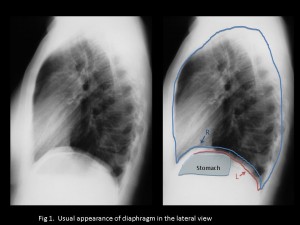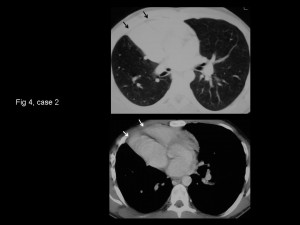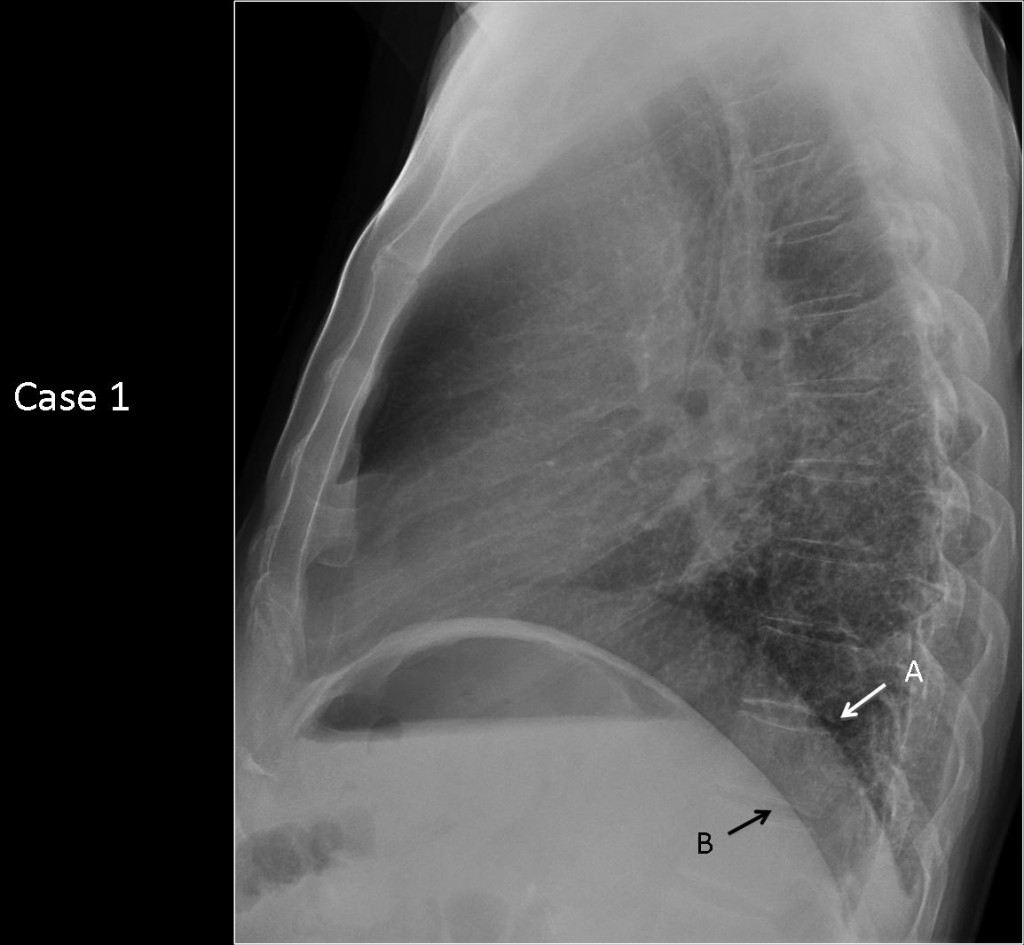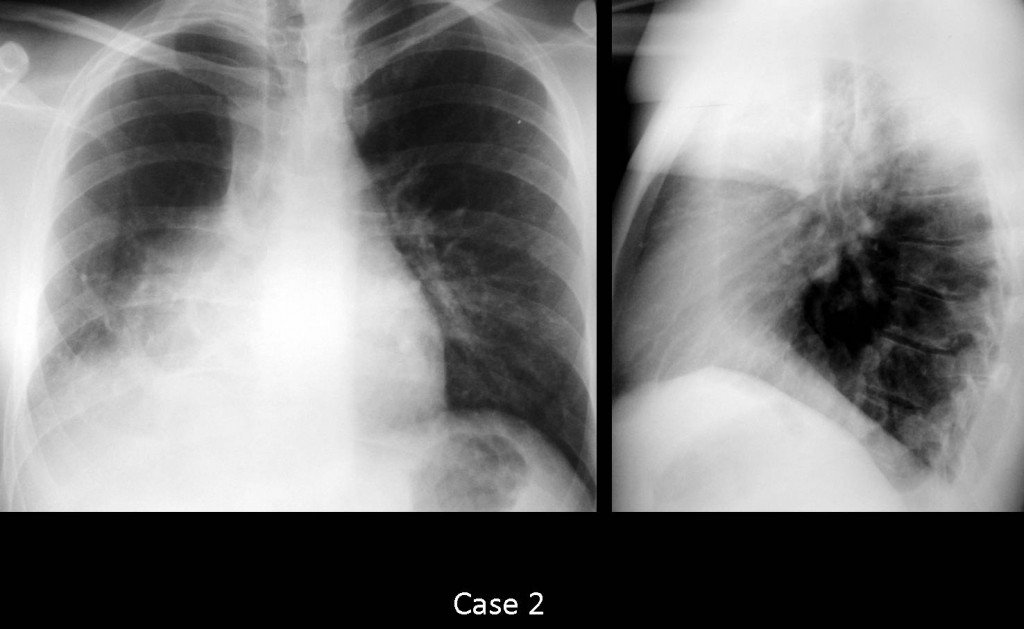Muppet has the silly notion that he is good at semiology and wants to test your interpretation skills with the following two cases.
1. A
2. B
3. Can´t tell
1. Yes
2. No
3. Can’t tell
Hope you enjoy the challenge. Answer next Monday.
Before giving an answer to case 1, it is necessary to understand the usual appearance of the diaphragm in the lateral view: the right hemidiaphragm is seen all the way and it is slightly higher than the left. The left hemidiaphragm is not seen anteriorly because the heart obscures the anterior portion and has the stomach bubble under it (see Fig 1).
The information in case 1 is misleading: one hemidiaphragm is higher (suggests right), but stops when reaching the heart (suggests left). The other goes all the way to the front (suggests right), but has the gastric bubble under (suggests left).

The explanation for this discrepancy is that the heart is in the right hemithorax, explaining the obliteration of the anterior portion of the right hemidiaphragm and the total visibility of the left one. PA confirms the findings: patient had unilateral left lung transplantation, with the expanded left lung pushing the heart into the right hemithorax and accounting for the findings in the lateral view (Fig 2).

The answer to case 2 is simple: even though there is blurring of the right heart border, it is not due to RML disease, as evidenced by the lateral view, which does not show the typical triangular appearance of RML disease (Fig 3). This case is a good example of hypogenetic lung syndrome (go back to case 6), with the typical findings of small hemithorax, shifting of the heart towards the right, and a scimitar vein (arrows). Blurring of the right heart border is common in this condition and it is secondary to rotation of the heart, which contacts with the chest wall and loses definition (silhouette sign) (Fig 4, arrows).


I’m sorry to say most of you failed this case (Muppet sad). Congratulations to all of you who made the diagnosis, especially Mm, who offered an excellent discussion (Muppet happy).
Incidentally, can you identify the right and left hemidiaphragms in the lateral view of case 2?









1 ans A
2 ANS yes
1.A
2.No
1.A
2.No
Case 1 – A
Case 2 – NO
1. Right diaphragm is the one not seen completely on lateral CXR. So the answer is A.
2. The patient has middle lobe disease.
According to Dr Felson, my mentor, the right hemidiaphragm is the one that extends farther anteriorly, because the anterior portion of the left hemidiaphragm is obliterated by the cardiac shadow.
Other criteria: the right one is higher and the left has the stomach bubble under it. So: which one is the right and which the left?
el diafragma derecho se puede ver en toda su extension tambien segun mi mentor luego la respuesta es la qu se ve en toda su extension
es un sindrome del lobulo medio en la pa pero no loes en la laterala de torax pues la densidad se situa ¡en el segemento anterosuperior del torax derecho, luego puede ser un sdme del lobulo medio masw afectacion del Lobulo superior anterior derecho
Can you think of an easier explanation?
1 A
2 Yes
Case 1 A
Case B yes
1. A
2. No
L’emidiaframma dx è A per 3 motivi:Il sx è contrasegnato dalla bolla gastrica;il dx è piu’ alto del sx; il grado di opacità del diaframma dx( in ll sx) è meno denso del sx.Per il 2 quesito: non si tratta di s: del lobo medio, perchè in LL l’opcità non è fusiforme e sospesa tra mediastino superiore ed inferiore. Tuttavia il segni della ” silhouette” cardiaca ,” cancellato” in AP ci dice che siamo nel mediastino medio: io penso allora o ad un esito di mediastinite o agli esiti di lobectomia inferiore.
1. A – unless there is dextrocardia (with the visceral organs where they usually are?)
2. Yes – there is a consolidation with smooth margins (the fissures?) in the lateral.
I meant to say A is probably the right hemidiaphragm, either because there is dextrocardia or… because Muppet’s teaching point is that the criterion of the anterior extension is not always correct?
I’ve already wrecked my brain over these cases.
Scimitar Syndrome as mentioned by Mm seems a very good idea.
I think the right hemidiaphragm is A. The anterior portion of the right hemidiaphragm is obliterated
by the cardiac shadow because the heart is located to the right (dextrocardia).
Considering that a lateral chest radiograph is taken with the patient’s left side of chest held against the x-ray
cassette, this x ray shows a poorly defined borders and magnified cardiac shadow, supporting dextrocardia
CASE 2.
ANSWEAR: NO.
You might think I’m crazy but I believe this case is a scimitar syndrome.
The lateral view shows a vertical retro-sternal band and elevation of the right hemidiaphragm. As was said in case 6: these findings are very suggestive of hypogenetic lung syndrome, secondary to congenital absence of one or two lobes of the lung. It almost always occurs on the right side. About 80% of the patients have anomalous venous drainage of the lower lobe (scimitar syndrome)
The front view shows a vessel cursing obliquely towards the inferior vena cava.
You are not crazy and your answer is correct. Muppet very happy!
Good thinking in case 1
Case 1: A
Case 2: No
Case 1:
A is right hemidiaphragm – higher and inserts anteriorly.
B is left hemidiaphragm. BUT heart is not sitting on the left hemidiaphragm – this is due to dextrocardia.
Situs solitus is present however.
Case 2:
Scimitar syndrome (TAPVR + hypogenetic right lung).
i think it is impossible to differ which of them is right or left hemidiaphragm. and there is no middle lobe disease .
1- A
2- yes
sell chanel outlet for more RCtOHEzM http://www.chaneloutlet-handbags.com/
you must read coach handbags discount for gift jArjpCNb http://www.discount-coachhandbags.net/